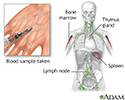Nitroblue tetrazolium blood test
NBT test
The nitroblue tetrazolium test checks if certain immune system cells can change a colorless chemical called nitroblue tetrazolium (NBT) into a deep blue color.
How the Test is Performed
A blood sample is needed.
Blood sample
Venipuncture is the collection of blood from a vein. It is most often done for laboratory testing.

The chemical NBT is added to the white blood cells in the lab. The cells are then examined under a microscope to see if the chemical has made them turn blue.
How to Prepare for the Test
No special preparation is needed.
How the Test will Feel
When the needle is inserted to draw blood, some people feel moderate pain. Others feel a prick or stinging. Afterward, there may be some throbbing or a slight bruise. This soon goes away.
Why the Test is Performed
This test is done to screen for chronic granulomatous disease . This disorder is passed down in families. In people who have this disease, certain immune cells do not help protect the body from infections.
Chronic granulomatous disease
Chronic granulomatous disease (CGD) is an inherited disorder in which certain immune system cells do not function properly. This leads to repeated a...
People who have frequent infections in the bones, skin, joints, lungs, and other parts of the body may have this test done.
Normal Results
Normally, the white blood cells turn blue when NBT is added. This means that the cells should be able to kill bacteria and protect the person from infections.
Normal value ranges may vary slightly from one lab to another. Talk to your doctor about the meaning of your test results.
What Abnormal Results Mean
If the sample does not change color when NBT is added, the white blood cells are missing the substance needed to kill bacteria. This may be due to chronic granulomatous disease.
Risks
There is very little risk involved with having blood taken. Veins and arteries vary in size so taking blood may be harder in some people than in others.
Other slight risks from having blood drawn may include:
- Excessive bleeding
- Fainting or feeling lightheaded
- Hematoma (blood accumulating under the skin)
- Infection (a slight risk any time the skin is broken)
References
Glogauer M. Disorders of phagocyte function. In: Goldman L, Schafer AI, eds. Goldman's Cecil Medicine . 25th ed. Philadelphia, PA: Elsevier Saunders; 2016:chap 169.
Riley RS, Mageau R, Ben-Ezra J. Laboratory evaluation of the cellular immune system. In: McPherson RA, Pincus MR, eds. Henry's Clinical Diagnosis and Management by Laboratory Methods . 22nd ed. Philadelphia, PA: Elsevier Saunders; 2011:chap 45.
-
Nitroblue tetrazolium test - illustration
Nitroblue tetrazolium test is a blood test that measures the ability of the immune system to convert the colorless nitroblue tetrazolium (NBT) to a deep blue. This test is performed as a screen for chronic granulomatous disease (CGD). If an individual has CGD, the white cells in their blood will not turn blue when exposed to the NBT.
Nitroblue tetrazolium test
illustration
-
Nitroblue tetrazolium test - illustration
Nitroblue tetrazolium test is a blood test that measures the ability of the immune system to convert the colorless nitroblue tetrazolium (NBT) to a deep blue. This test is performed as a screen for chronic granulomatous disease (CGD). If an individual has CGD, the white cells in their blood will not turn blue when exposed to the NBT.
Nitroblue tetrazolium test
illustration
Review Date: 2/8/2015
Reviewed By: Laura J. Martin, MD, MPH, ABIM Board Certified in Internal Medicine and Hospice and Palliative Medicine, Atlanta, GA. Also reviewed by David Zieve, MD, MHA, Isla Ogilvie, PhD, and the A.D.A.M. Editorial team.

